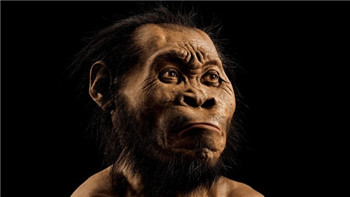(单词翻译:单击)

Deep within a South African cave palaeontologists have found a burial chamber of bones of primitive humans previously unknown to science.
在南非的一个岩洞深处,古生物学家们发现了一个埋葬着原始人类骸骨的墓穴,这种原始人类是此前科学家不知道的。
The hominids seem to have placed the bodies of their deceased there over many years — the first time such a ritual has been observed in a species other than Homo sapiens and Neanderthals.
这种原始人类似乎在很多年里一直将逝者的遗体放置在那里——这是科学家首次在智人(Homo sapiens)和尼安德特人(Neanderthals)以外的人种观察到这样的仪式。
The discovery of Homo naledi, as the new species is called, was announced at the University of the Witwatersrand in Johannesburg and press briefings in the UK. Details of the fossils, which are an extraordinary mosaic of primitive and modern features, are published in eLife and National Geographic.
这种新人种被称为“纳莱迪人”(Homo naledi),研究者在约翰内斯堡金山大学(Witwatersrand University)和在英国举行的新闻发布会上宣布了这种新人种的发现。这些化石不寻常地混合了原始人类和现代人类的特征,相关细节发布在《eLife》期刊和《国家地理》(National Geographic)杂志上。
An international team of 60 scientists has worked on characterising the bones of 15 individuals removed from the Rising Star cave 50km from Johannesburg since the initial discovery in 2013.
2013年初次发现后,由60名科学家组成的一个国际团队一直在致力于表征从距离约翰内斯堡50公里的“新星洞”(Rising Star)发掘出的15具骸骨。
“With almost every bone in the body represented multiple times, Homo naledi is already practically the best-known fossil member of our lineage,” said professor Lee Berger, the project leader. The species is named after its discovery site; naledi means star in the local Sesotho language.
“鉴于遗骨中几乎每一块骨头都出现多次,纳莱迪人实际上已经是人类世系中得到最完整了解的化石成员,”项目负责人李伯杰(Lee Berger)教授表示。该人种根据其发现地命名;“纳莱迪”在当地的塞索托语中意为星星。
Yet many mysteries remain; above all, the age of the fossils. The usual geological dating techniques have not yet given a result, leaving open the possibility that Homo naledi might have lived as long as 2.5m years ago, or at the other extreme, tens of thousands of years ago.
然而现在还有很多未解之谜;首先是化石的年代。通常使用的地质年代测定法还未给出结果,这意味着各种可能性都不能排除:纳莱迪人可能生活在远至250万年前,或者另一种极端情况下,他们生活在数万年前。
“Homo naledi is similar to modern humans in some ways, such as the shape of its hands, wrist and feet,” said Professor Chris Stringer, head of human origins research at the Natural History Museum in London. “On the other hand, Homo naledi’s small brain [just a third the size of an adult brain today] and the shape of its upper body are more reminiscent of prehuman and very early human species such as Homo habilis, which lived more than 1.5m years ago.
“纳莱迪人在某些方面和现代人类很像,如手、手腕和脚的形状,”伦敦自然历史博物馆(Natural History Museum)人类起源研究主管克里斯斯特林格(Chris Stringer)教授表示,“另一方面,纳莱迪人较小的脑部(仅为现在成年人脑部大小的三分之一)和上身的形状让人更多想起前人类和非常早期的人种,如生活在超过150万年前的能人(Homo habilis)。”
“Based on these features, Homo naledi could be one of the earliest species of human yet discovered, or a species that retained many features from an earlier stage of human evolution,” he added.
“根据这些特征,纳莱迪人可能是目前发现的最早的人种之一,或者是一种保留了许多人类更早期进化阶段特征的人种,”他补充。


